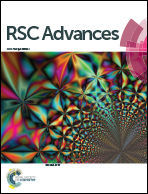Sol–gel synthesis of ZrO2–SiO2 catalysts for the transformation of bioethanol and acetaldehyde into 1,3-butadiene
Abstract
A series of ZrO2–SiO2 catalysts synthesized by sol–gel method were investigated for the 1,3-butadiene formation from bioethanol and acetaldehyde. The influence of ZrO2 content and reaction conditions on catalytic performance were studied. The catalysts were characterized by N2 adsorption–desorption analysis, temperature-programmed desorption of NH3 (NH3-TPD), IR spectroscopy of adsorbed pyridine (Py-IR), Fourier Transform Infrared Resonance (FTIR), X-ray diffraction (XRD) and Transmission Electron Microscope (TEM). These characterization results indicated that suitable intensity of acid sites, especially Lewis acid, are very crucial to obtain an active catalyst. The catalysts showed significantly higher selectivity for C4 chemicals, and 2 wt% ZrO2 content reached the highest selectivity to BD (69.7%), at space velocity (WHSV) of 1.8 h−1.


 Please wait while we load your content...
Please wait while we load your content...